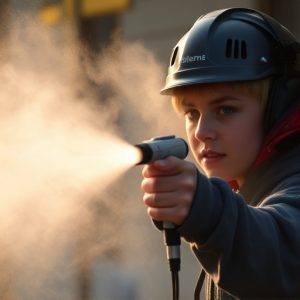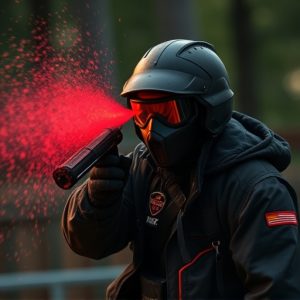Decoding Pepper Spray: Effectiveness, Usage, and Safety Considerations
Pepper spray, containing oleoresin capsicin, is a non-lethal self-defense tool that temporarily inc…….
Pepper spray, containing oleoresin capsicin, is a non-lethal self-defense tool that temporarily incapacitates attackers by causing intense irritation to their eyes and respiratory system. Its effects include severe pain, temporary blindness due to eyelid closure from the pain, and difficulty breathing. The spray's effectiveness can vary based on environmental conditions like wind and how close it is used to the target. While highly effective, it should be used responsibly within legal guidelines. Understanding its potential to cause temporary blindness, as addressed by the question "Can pepper spray blind you?" is crucial for safe and informed personal defense strategies. When selecting a pepper spray product, consider factors such as OC concentration, canister size, delivery mechanism, legality, shelf life, and maintenance to ensure effective protection. Pepper spray can indeed temporarily blind an attacker, rendering them incapacitated and allowing for a quick escape.
When it comes to personal safety, understanding the tools at your disposal is crucial. Self-defense spray, particularly pepper spray, is a non-lethal deterrent widely recognized for its effectiveness in potentially thwarting attacks. But questions arise about its use—such as the concern, “Can pepper spray blind you?” This article delves into the capabilities of self-defense sprays, exploring their science and effectiveness, as well as guiding you on selecting the most suitable option for your safety needs. Join us as we dissect the potency, range, and duration of this defense mechanism, ensuring you’re equipped with knowledge to use it responsibly and effectively should the need ever arise.
Understanding the Capabilities of Self-Defense Spray: Can Pepper Spray Blind You?
Understanding the capabilities of self-defense sprays, such as pepper spray, is crucial for anyone considering it as a personal safety tool. Pepper spray, also known as oleoresin capsicum (OC) spray, is designed to temporarily incapacitate an assailant by causing intense irritation to their eyes, skin, and respiratory system. When deployed, the active ingredient in pepper spray, capsaicin, reacts with nerve endings, particularly those in the eyes, triggering a reflexive response that can lead to temporary blindness. This effect is not a result of actual damage to the eye, but rather a physiological reaction causing the eyelids to close uncontrollably due to the intense pain and burning sensation. The intensity of this reaction can vary based on factors such as wind conditions, proximity to the target, and the specific formulation of the spray. It’s important to note that while pepper spray can effectively deter an attacker, its use should be a last resort in self-defense situations, and users should familiarize themselves with local laws and regulations regarding its deployment. Understanding the potential effects of pepper spray, including its temporary ability to cause blindness, empowers users to make informed decisions about their personal safety strategies.
The Science Behind Pepper Spray: Effectiveness, Range, and Duration
Pepper spray is a non-lethal self-defense tool that has become a common deterrent against physical attacks due to its effectiveness and relative ease of use. The substance at the core of pepper spray’s defensive power is oleoresin capsicum (ORC), derived from chili peppers. When deployed, it irritates the eyes, skin, lungs, and throat of an attacker, causing a range of debilitating effects including temporary blindness, difficulty in breathing, and intense pain or burning sensation. The intensity of these reactions can be so overwhelming that they significantly impair an individual’s ability to see for a period ranging from 15 minutes to half an hour under typical conditions. This temporary “blinding” effect allows users to escape dangerous situations and seek safety.
The effectiveness of pepper spray is not solely based on its ability to cause temporary blindness but also on its range and duration of impact. Pepper sprays are typically designed to discharge a fine mist or foam that can travel up to 10 to 12 feet, depending on the brand and model, enabling users to maintain a safe distance from potential threats. The particles in the spray are small enough to penetrate into the eyes of an assailant, even if they are wearing sunglasses or contact lenses, which is often a misconception regarding its effectiveness against individuals with vision correction. Furthermore, the effects of pepper spray are long-lasting due to its slow evaporation rate, ensuring that it continues to be effective until it dissipates or is washed off by rain or water. Users should be aware of environmental factors such as wind, which can affect both the range and duration of the spray’s efficacy, and should practice with their pepper spray to understand its capabilities in different conditions. Understanding the science behind pepper spray empowers users to utilize this self-defense tool effectively and confidently in emergency situations.
Choosing the Right Self-Defense Spray: Factors to Consider for Personal Safety
When selecting a self-defense spray, understanding the factors that contribute to its effectiveness is crucial for personal safety. One of the primary considerations is the concentration of the active ingredient, typically oleoresin capsicum (OC), which determines the potency of the spray. A higher concentration can increase the likelihood of incapacitating an attacker by causing intense irritation to their eyes and respiratory system, potentially blindings them temporarily, as with pepper spray. The volume or size of the canister also plays a role; larger cans may offer more protection but should be compact enough for easy carriage. Additionally, the delivery mechanism matters—sprays that create a dense fog are generally more effective than streams or gels, as they can quickly engulf an assailant’s face and reduce the risk of contaminating the environment or oneself. Consider the legal restrictions specific to your area when choosing a self-defense spray; some regions have limitations on pepper spray’s strength and size. Furthermore, familiarize yourself with the product’s shelf life and maintenance requirements to ensure it remains effective during its intended lifespan. By carefully evaluating these factors, you can select a self-defense spray that offers reliable protection and suits your personal safety needs.


